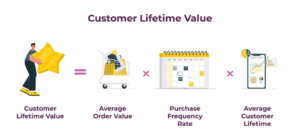Customer lifetime value (CLTV) is one of the most important metrics to measure. However, not all customers are created equal. If you’ve ever run a business (or even just been a customer yourself), then you know that some customers provide more revenue (and cost less to retain) than others. Figuring out which to focus on and invest in is critical if you want to maximize your profit.
Many companies use a calculation called customer lifetime value (CLTV) to determine how much a customer is worth in comparison with others. Even if you don’t have to calculate CLTV yourself, it’s important to understand the concept so you can decide whether to use it when making marketing and sales decisions.
The definition of Customer Lifetime Value is simple: Customer Lifetime Value represents a customer’s value to a company over a period of time.
CLTV should be the primary and fundamental metric retailers measure and evaluate the performance of their campaigns with. In other words, how much is a shopper’s worth to them and how much are they willing to pay to find more of the same customers. You can calculate a simple Customer Lifetime Value model for your company with this formula:
Why you should calculate customer lifetime value (CLTV)
One of the key reasons for measuring CLTV is customer retention. Marketing Metrics reveals that the probability of selling to a new prospective customer is 5%–20%, while the probability of selling to an existing customer is 60%–70%.
It means that selling more to repeat customers will bring significantly more profits. That also highlights the impact of promoting customer loyalty. Regular customers tend to spend more on your products, helping you grow and promote your business. According to a Criteo survey, 81% of marketers claim that monitoring CLTV boosts sales. So if we accept the premise that it’s more effective to market your services to existing customers, it helps to have a strategy to ensure you’re keeping them happy.
How to Improve Your Customer Lifetime Value (CLTV)
Having trouble getting your customers to increase their spending? Try these campaigns, which focus on providing incentives to increase average order value:
- Add personalized product recommendations to your website. The recommended products should be based on the ideal price point for each individual customer, thereby maximizing revenue.
- Send personalized newsletter campaigns with dynamic product recommendations optimized for price.
- Trigger product recommendations, based on what they’ve added to their shopping cart, directly on the site.
- Send an email campaign with product recommendations based on what they’ve added to their shopping cart.
- Create product bundles that offer a discount for making a larger purchase. Bundle products that can be used together, and recommend the bundle directly on the site, or through email, based on the user’s browsing and shopping cart history.
- Create a customer loyalty program, incentivizing spending by adding loyalty points that customers can use for discounts and freebies.
How to Improve Your Purchase Frequency
Maybe your customers spend a lot, and you’re making a great margin, but they just don’t order very often. Try a few of these campaigns to maximize profit by getting your customers to pick up the pace:
- Communicate dynamically. Using historical customer data collected with a true unified Single Customer View, you can automatically send emails that arrive at the ideal time for each individual customer. (Make sure those emails are personalized!).
- Find out if you’re communicating through the right channels – does this particular customer respond better to email or SMS? Make sure each customer receives your message through their preferred channel.
- Segment your customers by their customer lifecycle stage, then re-engage with customers who haven’t purchased in a while, and are in danger of churning.
- Use push notifications and banners to highlight time sensitive deals based on their browsing history.
- Use banners that trigger when a customer enters and exits the site. Use these banners to recommend personalized products or sales.
Using CLTV effectively can improve customer acquisition and customer retention, prevent churn, help you plan your marketing budget, measure the performance of your ads in more detail, and much more.
Here are a few great ways to use CLTV:
Now you know that the ads you invested in to acquire David can actually create more value than the ones that acquired Adam. Scale that with the data of all your customers, and you get the full picture of which ads are most effective for your business.




